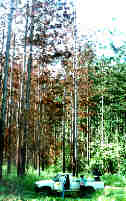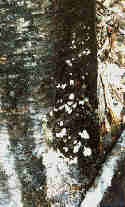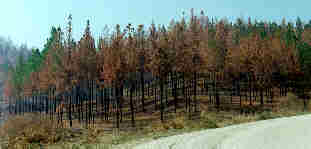



Damaged Hoop Pine
plantation during the drought in 1997 (left); pin- and
shot-holes in a fire-damaged Hoop Pine (second from
left); fungal growth at the base of a fire-damaged Hoop
Pine (second from right); agroforesty garden in newly
established plantation (right)
Due to the fact that fires are mainly man-made, awareness campaigns with the aim to change the attitude of the people who set fires are the only reasonable means of tackling this problem. The strict enforcement of the respective laws would be also desirable in order to deter people from arson. Otherwise little can be done in order to prevent fires. It is certainly helpful to propagate a ground cover of the legume Desmodium uncinatum preventing or at least slowing down the spread of fires in newly established plantations. Furthermore, it might be worthwhile to allow gardening in newly established plantations so that local people might learn to appreciate the value of forestry and thus possibly become more cautious with fire. Apart from that, fire resistant Pinus sp. can be planted in notorious areas, even though these species might not survive fires.


Ground cover with Desmodium
uncinatum (Leguminosae) in newly
established plantations slows down the spread of fire and
acts as a natural fertiliser (left); a plot of apparently
fire-resistant Pinus sp.
fell prey to man-made fire (right)